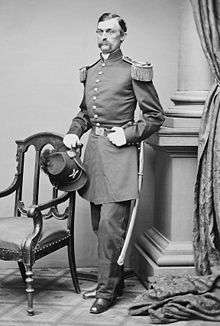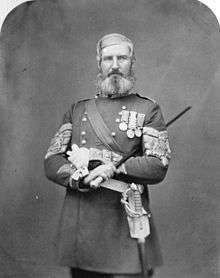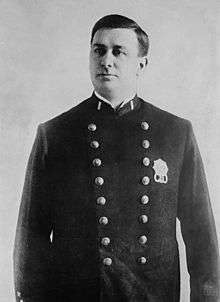Tunic (military)

A military tunic is a type of medium length coat or jacket, the lower hem of which reaches down to the thighs all the way round. It is named after the tunic, a garment of similar length worn in Ancient Rome.
Development
In the second half of the seventeenth and into the eighteenth century, European soldiers wore a coat of a similar style to the civilian justacorps, which had wide skirts and was decorated with lace at the front and had broad cuffs. As the eighteenth century progressed, coats became tighter and broad lapels to expose the facing colour were introduced, initially in the Prussian Army. The skirts of the coat were turned back to form tails; this was initially a mark of the dragoon cavalry, but was soon adopted by the infantry too.[1] By the start of the nineteenth century, this had evolved into a jacket that was cut to waist level at the front and had a short tail behind; in the British Army, this was called a "coatee".[2] A coat with a skirt that reached down to thigh length had been introduced into both the Russian and Prussian armies at the end of the Napoleonic Wars, but was not widely adopted. However, by the end of the 1830s, there was a feeling that uniforms didn't offer soldiers sufficient protection from the elements or freedom of movement. While Russia experimented again with the tunic, Prussia adopted them for their whole army in 1842.[3]
Adoption
France followed Prussia's lead, introducing a tunic for their line infantry in 1845.[4] In 1851, the US Army introduced a long type of tunic which they called a "frock coat".[5] The British eventually followed suit in 1855, their initial French-style double breasted tunic being replaced by a single breasted version in the following year.[6] The tunic became almost universal military wear; at the start of the twentieth century, when the need for some kind of concealment became apparent, armies changed to drab coloured uniforms, the British and Americans in 1902, the Germans in 1910.[7] In the British Army, the tunic continued as a field uniform until the introduction of Battle Dress in 1938;[8] the tunic continues to be worn for formal and ceremonial occasions.
Non military use
The military tunic was quickly adopted by civilian organisations that needed a smart and practical uniform. It was introduced into the Royal Mail in 1868,[9] and by the Metropolitan Police in 1864, replacing a tail-coat.[10]
Gallery
-

Prussian soldiers in tunics, 1845.
-
A member of the Garde nationale mobile in 1848, showing the long-skirted French Army tunic.
-

A Captain the United States Army during the 1860s wearing the long tunic or "frock coat" adopted in 1851.
-

A Sergeant Major of the Scots Fusilier Guards wearing the double breasted tunic briefly adopted by the British Army in 1855.
-

A Lieutenant of the New York City Police Department in 1912.
-
.jpg)
A Sergeant Major of the Leicestershire Regiment during the First World War in the 1907 pattern Service Dress tunic, with large patch pockets and a "rise-and-fall" collar.
-
.jpg)
Two British staff officers wearing the officer's 1913 version of the Service Dress tunic, which featured an open collar revealing a shirt and tie below.
-

Senior British and French officers in 1925 showing contrasting styles of formal uniforms.
-

An officer of the Royal Netherlands Army asks directions from a Metropolitan Police Officer in London, 1942.
-

Soldiers of the North Korean Army in 2005.
References
- ↑ Kannik, Preben (1968), Military Uniforms of the World in Colour, Blandford Press Ltd, ISBN 0-71370482-9 (pp. 160-161)
- ↑ Kannik, p.270
- ↑ Kannik, p.208
- ↑ Kannik, p.212
- ↑ Kannik, p.216
- ↑ Beckett, Ian F W (2007), Discovering British Regimental Traditions Shire Publications Ltd ISBN 978-0-7478-0662-2 (p. 89)
- ↑ Kannik, pp.234-239
- ↑ Kannik, p.245
- ↑ "British Postal History - Uniforms". postalheritage.org.uk. The British Postal Museum & Archive. Retrieved 27 February 2014.
- ↑ "Met Police Timeline » Period 1829 - 1899 (p.6)". www.metpolicehistory.co.uk. Friends of Met Police Historical Collection. Retrieved 27 February 2014.